
Nick MacKinnon is a freelance teacher of Maths, English and Medieval History, and lives above Haworth, in the last inhabited house before Top Withens = Wuthering Heights. In 1992 he founded the successful Campaign to Save Radio 4 Long Wave while in plaster following a rock-climbing accident on Skye. His poem ‘The metric system’ won the 2013 Forward Prize. His topical verse and satire appears in the Spectator, and his puzzles and problems in the Sunday Times and American Mathematical Monthly. Email: nipmackinnon@gmail.com
Dr Ghazi Mohammed Ahmed Osman (Director) and Mr Christopher David Griffin Wilson (Executive Chairman) of Calderdale Wind Farm Ltd were given an opportunity on 13 September 2024 to respond to the questions in this blog. Calderdale Wind Farm Ltd refused to respond on 18 September 2024.
Turbine 62 Burnt Hill Flat SD 97139 34946 ///apparatus.meaning.princes

On 18 October 2024, the bright hopes of CWF Ltd unravelled. According to their FAQ 18, they had been working towards a planning application to Calderdale Council “in summer 2024”.

On Calderdale Wind Farm website you will now find only a front page, which is not a photograph of anywhere in Calderdale. There are no answers to the questions that people in Calderdale and elsewhere were frequently asking. There is no map of Calderdale Wind Farm. The link FIND OUT MORE simply scrolls down the single page to a statement that says CWF is not engaging with local communities now. The link to 23 FAQs has been removed.
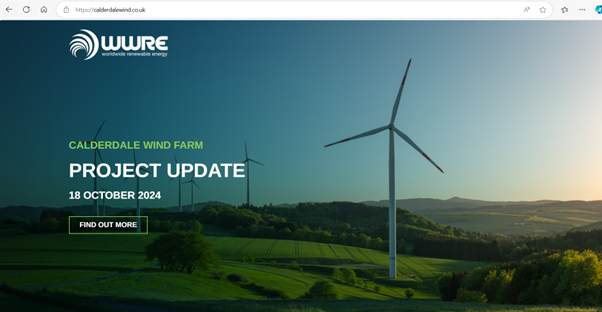
Executive Chairman Christopher Wilson throwing his FAQs out of the pram is in hilarious contrast to his sanctimonious FAQ 22.

It is typical of CWFs corporate muddle that it is still possible (19 October) to find the lost FAQs by adding “/site” to the address. They haven’t taken down the old site with the weirdly amateur FAQs!
I predicted a sudden vanishing in T17 Jackson’s Ridge on 18 September, where I wrote “This new FAQ 17 was obviously written in a panic, and it may not be up long.” I wasn’t expecting them to defoliate the whole site a month later! I said then that Muttley was in trouble. This blog will consider just how much.
The site now has a single statement. It is so funny that it needs no commentary from me.
“[…] Following the scoping process for Calderdale Wind Farm in late 2023 and early 2024, environmental & technical surveys and studies have been progressed to help inform the shape of a future design for the Project. This work has shown that the site can deliver renewable energy with an installed capacity exceeding 100MW.
If the anticipated planning reforms proceed, the project will therefore require formal approval through the Development Consent Order (DCO) process, which will be overseen by the Department for Energy Security & Net Zero. The NSIP designation sets clear expectations for community consultation, and Calderdale Wind Farm Ltd. is committed to meeting these requirements as the DCO application is prepared.
Whilst we are not engaging with local communities at this time, the project team is progressing the preliminary proposals and will provide further information in advance of non-statutory consultation with the local community in Spring 2025. Feedback received during the non-statutory consultation period will be used to inform the preparation of the DCO application ahead of a further round of statutory consultation next year.
Calderdale Wind Farm Ltd remains fully committed to delivering a project of national importance at Walshaw Moor. We remain firmly of the belief that the Project presents a real opportunity for Calderdale and the wider area to play a substantial role in the UK’s Net Zero transition.”
“We firmly believe…” was in the old FAQ 22 about the immense importance of community engagement. Students of football will recognise “remains fully committed” and “firmly of the belief” as phrases uttered by the board when a manager has lost the dressing room.
Some grumpy people will moan about objectors holding up infrastructure. They would be wrong. The 302 MW CWF scoping report for Calderdale Council had already been self-shredded by incoherent public statements signed off by the Executive Chairman. Now it is binned. The WWRE website is almost blank now because it was once full of abject rubbish. There isn’t even a map of Walshaw Moor. Even The House at Pooh Corner has a map, but then the Executive Chairman of Hundred Acre Wood is Christopher Robin not Christopher Wilson.
Here’s the timeline.
14 September 2023 at 00:00:00. Calderdale Wind Farm is accepted to connect by Electricity North West. This is the DNO at 275 kV not the National Grid at 400 kV. The entry in the embedded capacity register (ECR) is crisp. CWF will have a maximum power of 240 MW and be connected by a 132 kV cable from a substation at Shackleton to the DNO substation in Rochdale. The grid reference of the substation is 398318 429563, postcode HX7 7AP, geopoint 53.762417…, -2.026993 … The energy source is WIND, the battery capacity is entered as 0 MW. The substation position is over 2 km south of the published boundary and is therefore offsite. All this remarkably precise information was surely signed off by Christopher Wilson because it’s his wind farm, and he gives the orders.
18 September 2023 The Scoping Report for Calderdale Wind Farm is handed to the client Christopher Wilson. The report gives the layout of 65 turbines on a map with a red boundary. The report says that the substation for the wind farm is onsite, and the battery must be “close to the substation”. The battery is 50 MW, covering one hectare. The scoping report is already at variance with the ECR.
20 September 2023 The WWRE website appears with 23 FAQs, some of them answered to six significant figures. The calculations all depend on an installed capacity of 302 MW, not the 240 MW of the application to Electricity North West. Everything on the website contradicts everything in the ECR. There are already three announced battery sizes: 0 MW (ECR), 50 MW (Scoping), 150 MW (Website).
FAQ 17 states that the National Grid has “440 Kelvin Volt pylons” and CWF has an offer to connect “into” the local electricity network substation at Padiham.

Padiham! Now there are three CWFs with various powers, battery sizes, substations, and points of connection. Christopher Wilson has let the narrative spin out of control in less than a week.
1] a 240 MW ECR wind farm accepted to connect at Rochdale with an offsite substation at Shackleton and no battery storage.
2] a 302 MW scoping wind farm that is not accepted anywhere with an onsite substation and a 50 MW battery on one hectare next to the substation.
3] a 302 MW FAQ17 wind farm “accepted to connect at Padiham” with an onsite substation and battery storage of 150 MW. There is no acceptance to connect at Padiham and there never has been.
Notice how everything in 1] is contradicted by everything in 3] while 2] isn’t altogether about either.
Christopher Wilson will never reunite this centrifugal horlicks, which is going to get much worse a year later, so that all they can do is scrub the lot and start again. Some people think the National Grid runs at 440 kV. Some people think the unit of NG potential difference is Kelvin Volts. But the only person who thinks the National Grid has “440 Kelvin Volt pylons” and is also the Executive Chairman of a wannabe electricity generator is Christopher Wilson.
11 October 2023. This is the last time the embedded capacity register is updated. Had he been working at the full “440 Kelvin Volts” today, Christopher Wilson might have given CWF a coherent narrative before anyone noticed he’d made public three very different wind farms. The chance is muffed.
11 December 2023 At a meeting with the Hilltop Parishes, summarised by Jenny Shepherd, Christopher Wilson says that the minimum economic power of CWF is 200 MW. He also says that there is no transport plan to get the materials for construction onto the site. He should have asked our mole Deep Stoat, who knows the main thing about the transport plan. Christopher Wilson says an advantage of CWF is that it can be linked “into” the National Grid. CWF isn’t linked into the NG. It is accepted to connect to the 275 kV DNO substation at Rochdale. National Grid have better things to do than plan transmission for speculative multiple-personality wind farms, just because someone wants to shift their inglorious grouse moor.
1 March 2024 A mole (“Deep Stoat”) close to Richard Bannister informs MacKinnon that the sole access to CWF will be off the Oxenhope-Hebden Bridge road “at the Elephant.” Now logistical calculations have a firm foundation. Everything must get to Cock Hill Swamp.
15 March 2024 A flock of fifty golden plovers lands above Stanbury.
18 March 2024 First curlew seen on CWF.
5 April 2024 Raucous birds nesting on the site compound at Cock Hill Swamp drown the traffic. Today MacKinnon discovers that the onsite rock is too weak and porous to make roadstone or concrete. It’s in the notes to BGS Map 69 Bradford and the annual West Yorkshire Aggregate Assessments. A dynamic Executive Chairman might have asked if Natural Power had looked at a map. On a site visit, Mr Wilson might have asked a gamekeeper “Why isn’t this track brown?” The gamekeepers might even have taken Mr Wilson into their confidence unasked, but for this bit of gratuitous rudeness.

Whatever you think about grouse shooting, you can hear the dismissiveness in that one. This is amateur work but all the FAQs have this amateur character. It suggests a shortage of ability at the hub of CWF Ltd, because in any group of three professionals there is always one who can do better than this.
25 April 2024 First cuckoo heard on CWF.
This gap in the timeline is because we don’t visit the turbine sites when the birds are nesting, and everything is discovered on the walks. While the curlew chicks are fledging we will roll the Season One credits. Bob Berzins lent his reputation and knowledge when these blogs had just begun. Ali West, Stella King, and Sheila Tilmouth are frequent companions and firm friends. John Page, Richard Lilley, Chris Goddard, Kanagra Writers and Kate Haslegrave have all written Walshaw Turbine blogs. Johnnie Turner gave us five hours bent double on Crown Point Flat and Lou Crosby got us off CPF and produced brilliant posters. Lydia MacKinnon who leads the Worth Valley section of Stronger Together made vital remarks about the jokes and found a much wider audience for the blogs. Mark Avery has been fantastic and gently squashed T49 Sutcliffe Plantation when the summer layoff had got the better of me.
15 August 2024 While on a walk to Slack Stones with Ali West, Sheila Tilmouth and Stella King (who has been talking to somebody at the National Grid) King tells MacKinnon that earliest connection dates might be deducible from publicly available datasets. After three days searching, MacKinnon becomes (surely!) the first person to read the CWF ECR entry since Christopher Wilson signed off the update on 11 October 2023.
13 September 2024 MacKinnon puts two sets of questions to Kevin Whitmore of Cavendish Consulting. These questions explore the inconsistencies in announced power and announced connections and the weakness and porosity of the onsite aggregate.
18 September 2024 13.38 CWF Ltd (not Kevin Whitmore) refuses to answer MacKinnon’s questions on the grounds that his blogs (all of which they have read in detail) associate them with Muttley, the cartoon dog in Wacky Races. There is a more serious allegation about MacKinnon’s feelings for Muttley but you’ll have to read the blogs because they don’t want any more talk about Wacky Races and they said so in CAPITALS. MacKinnon assumes this refusal was signed off by Christopher Wilson because of the simultaneous major policy announcement in the FAQs, for the day is yet young …
18 September 2024 16.30 A new FAQ 17 appears on the website, the first for a year.

In this panic about the Padiham Connection, two more versions of CWF have been announced, neither remotely convincing.
4) A 312 MW version that might as well be “directly connected by the NG to Narnia.
5) “Up to 170 MW” connected at Rochdale to the DNO.
Christopher Wilson has presumably forgotten that he said on 11 December 2023 that a 170 MW CWF is uneconomic, while CWF was accepted to connect 240 MW at Rochdale on 14 September 2023. 312 MW looks like a typo for 302 MW, the power of a website version of CWF.
19 September 2024 Following a packed meeting in Haworth, Nick and Lydia MacKinnon meet Robbie Moore M.P. in Keighley, who agrees to ask the questions CWF refused to answer, on House of Commons notepaper and to take up the climate dangers of wind generation on peat. At the Haworth meeting, both political invitees Robbie Moore (Con. Keighley & Ilkley, Shadow Defra Minister) and Pam Johnson (Keighley Labour) speak exceptionally well. (Pam: “This isn’t about renewable energy. This is about a rich man and venture capital.”) Mark Avery drove up from Northamptonshire to give a rousing speech and tell us how much his judicial reviews cost. Send a donation to Wild Justice!
4 October 2024 T17 Jackson’s Ridge is published, describing the way “The Executive formerly known as Muttley” has let the narrative spin out of control. MacKinnon says the new FAQ 17 “will not be up long”. He adds that were he Dr Osman, he would be asking Muttley three questions.
“Why are we spending money on surveys when we don’t know how big our wind farm is even to one significant figure?”
“Why did we pay for a scoping report that you have shredded with your own public announcements?”
“Does my battery look big in this?”
18 October 2024 A fortnight proves MacKinnon’s prediction correct. FAQ 17 disappears with all the rest. The website now has a single page in boilerplate phrases. With, by now, familiar CWF Ltd muddle, the old front page with the FAQs is still live. It really must be a skeleton crew at CWF. Nobody can write convincing FAQs; nobody understands the National Grid; and now there is no tech bro to kill off the old site. What talents do the skeleton crew possess?
The consultees of the Scoping Report cannot assess the environmental impacts of the wind farm if they don’t know its power even to one significant figure, so the Scoping Report was already shredded by the out-of-control narrative before it was dumped. You can’t say silly things like “The number of houses supplied by CWF is 310372” without knowing the power of the wind farm, so that shreds the website too, and down it comes. There is now no map. The Weirdstone of Brisingamen and Tolkien’s Middle Earth both have maps. What next?
19 October 2024 Dr Osman presumably “remains fully committed” to his Executive Chairman despite him shredding his own scoping report by making public four powers (312, 302, 240, 170) three connections (Padiham, Rochdale, Narnia?), two substation-and-battery positions (“onsite” and Shackleton) and three battery sizes (0, 50, 150) for a total of “up to” seventy-two versions of CWF. Dr O may remain “firmly of the belief” that Christopher Wilson will eventually present the Planning Inspectorate with just one commercially viable wind farm that will not become the dirtiest power station in England and destroy an SPA and an SAC. If so, then Dr O has more faith in Christopher ‘Kelvin Volts’ Wilson than we do.
Putting down the peat probe for a moment, I’m going to say something about the money which really matters to all British people, and I wish it didn’t.
It came with my job to know a lot of ‘the money’ and those who work for it. We need competent, intelligent executives to manage our transition to Net Zero because we are trying to do it with other people’s money in a venture capital model, and other people’s money wants a stable narrative. We are in such a hole that we cannot afford to muck about with other people’s money anymore. We depend on the kindness of strangers.
What is Christopher Wilson bringing to the job that compensates for his failure to maintain a stable public narrative about the simplest facts? How big is it? Is the substation onsite or offsite? Where will it connect? How big is the battery? Where’s the aggregate coming from? What’s the voltage of the National Grid? Where on the map is Calderdale Wind Farm? Where is the map?
Let’s go for a walk, and then we’ll read the horoscope of Christopher Wilson and CWF Ltd.
13 October 2024 It has been a still, dry week on Walshaw, with pink and green Northern Lights on Thursday. Approached from the reservoirs, T62 Burnt Hill Flat would seem a remote fold in the hills. The dog and I get there the way the sixty-metre blades must come, down from the popular path between Top Withens and Alcomden Stones, that only became a legal walk with the CRoW Act (2000).
The double-barrelled opposition to CRoW was naturally concentrated in the House of Lords, where Lord Whitty, the Labour whip, said something memorable as the last words of the final debate.
“In the spirit of compromise and balance, which I have advocated throughout the Bill, we have not taken the land away from the landowners, who have recognised their responsibilities. Tonight, we have, to some extent at least, given the land to the people.”
It is a pity that many people who have slogged up to Wuthering Heights don’t exert their CRoW rights, take 10 more minutes to the trig point, and get the sudden view of the unmitigated moor, so at variance with the sheltered Withens farms. The two strongest winds I have walked in were on the col between Ben More and Stob Binnean in October 1983 and right here in October 2020. A storm in the South Pennines has a solid quality I’ve not met in Atlantic Scotland, though I’ve never been on the Cairngorm plateau in more than a following gale. The difference is that tens of thousands of people experience the Pennine wind as a main factor in daily life.
Today I can see Ovenden, Scout Moor and Crook Hill wind farms and none of them are generating; they are enjoying one of the 255 days off contracted by their 30% load factors. CWF will have to work harder. DESNZ want a 34.1% load factor for future onshore generation and in the jetwashed FAQ7 the developers claimed 302 MW CWF would have achieved 38%. Will they get above 34% if they cut CWF to the 170 MW fall back?
I’ve got a 3-metre aluminium avalanche probe bought on eBay for £27. It’s easy to tell when you’ve reached the bottom of the peat because suddenly the probe won’t go in any further, like a skewer through butter meeting the butterdish. We need to check the developer’s peat survey, because we use the depths to calculate the carbon intensity estimate.
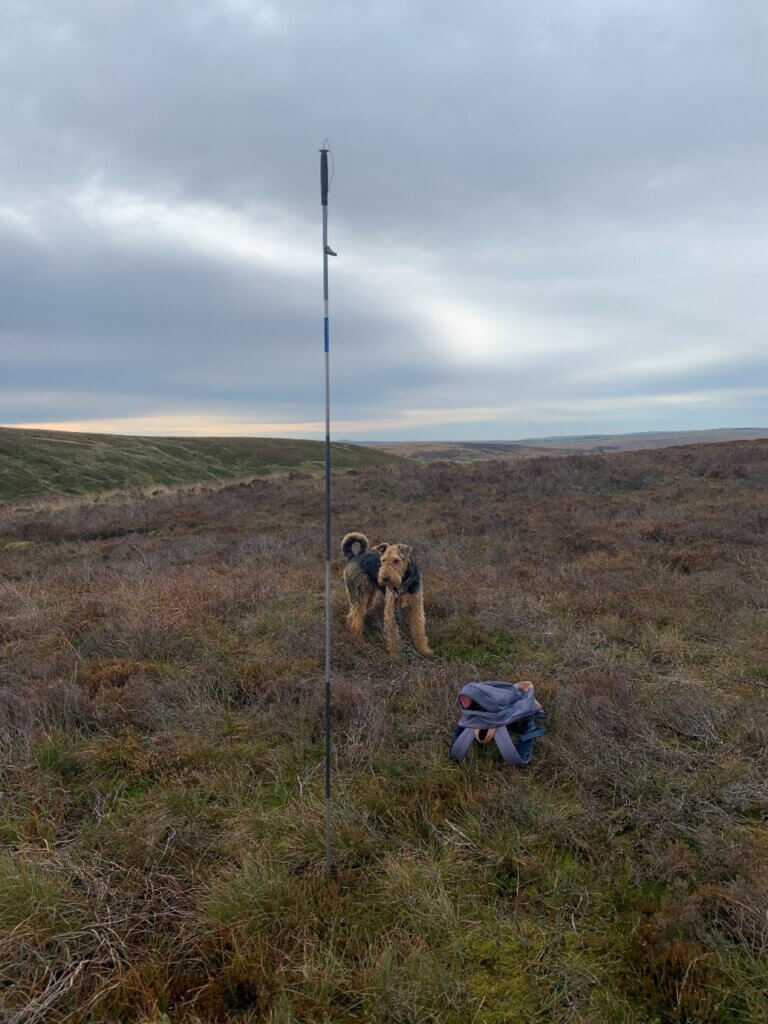
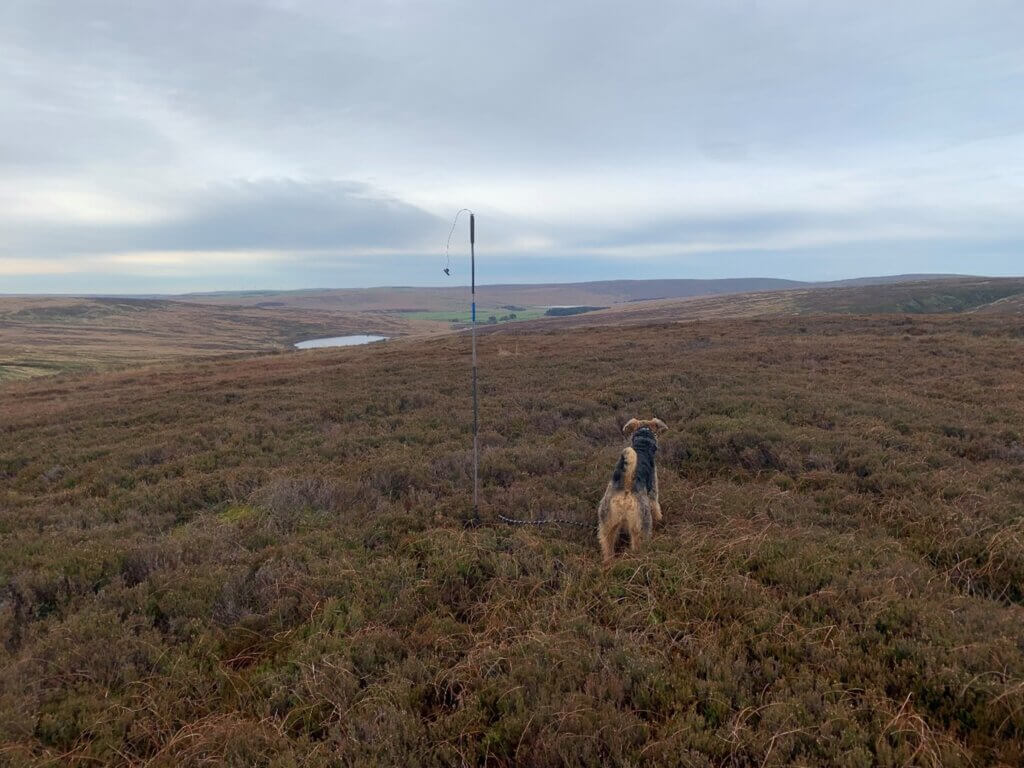
It is difficult to hit off the Burnt Hill nose from above. If you want to go to Burnt Hill Flat, and I can’t think why, keep further left than you think and never leave the heather. I have dropped down from the trig point twice now, and both times got myself in trouble on very difficult ground. Even the Airedale struggled in the rushy bog on the lead, though left to himself he’d have powered to T46. Airedales served in the trenches.
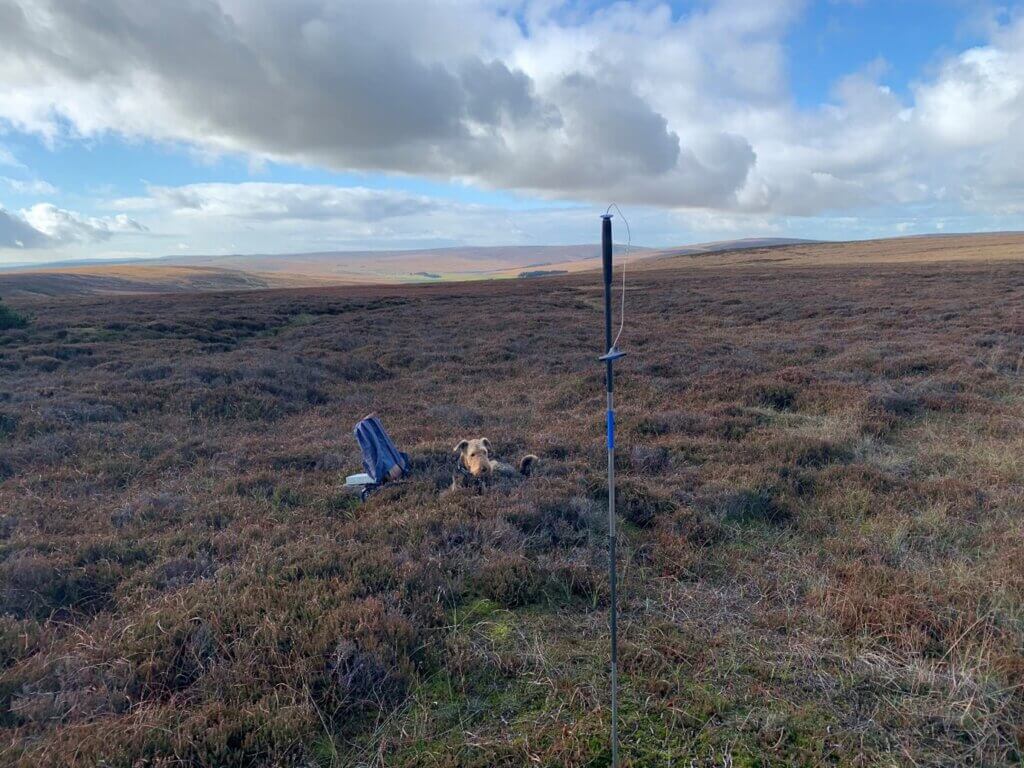
Until I stuck a probe into peat, I hadn’t started to understand it. I probe very boggy bits and find the peat to be … shallow. Elsewhere there is active sequestration going on and lots of moss and the peat is … shallow. On some dry heathery ground, the peat is … very deep. Present vegetation is not representative of the last four thousand years.
Today the deepest peat I probe is under a dry mown strip of heather on my way back up the steep nose, down which the access track must come, for a turbine blade can’t come across Bakehouse Clough on a contour. The next photo tries and fails to convey the steepness of this 10% toboggan slope down to the runout on Burnt Hill Flat. This will be the scariest delivery on CWF.
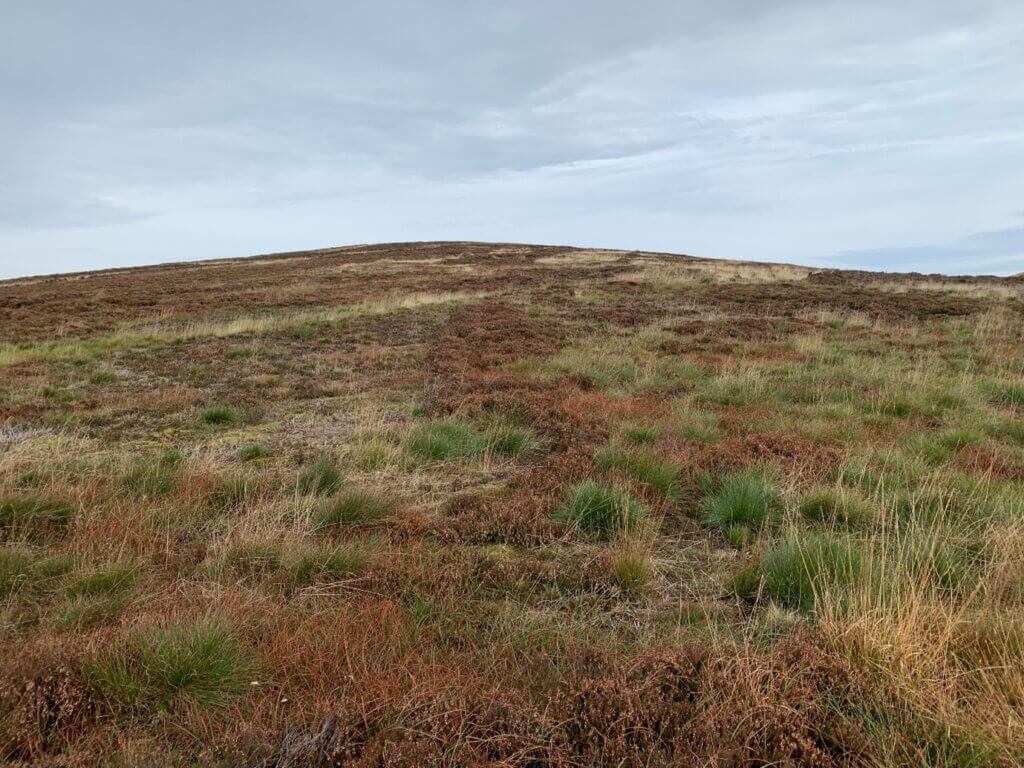
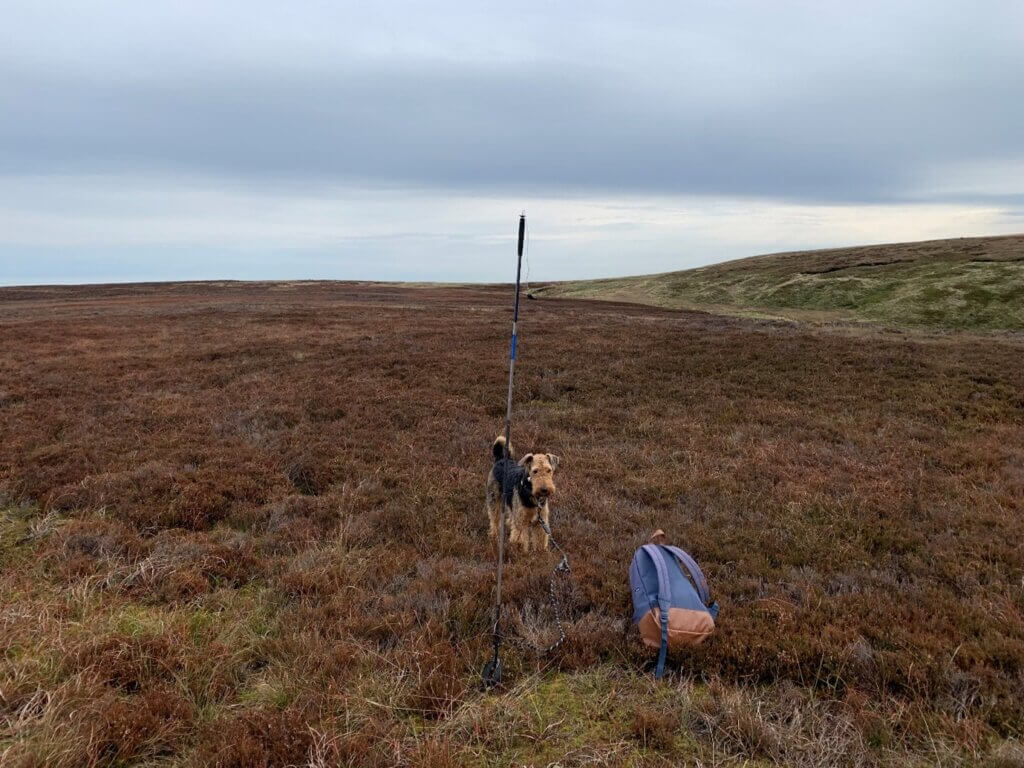
I have said elsewhere that the Natural Power peat survey map looks slipshod in the far east, but wherever I have probed it among the Brontë skyline turbine sites, and John Page has probed it on White Hill, the map has been spot on. There is much that is comically incompetent in the scoping report, but the peat survey may have cost £200,000 and would be essential in planning the track network. I trust it for the carbon intensity calculations.
Here is a map of the Brontë skyline turbines and what the tracks must look like.
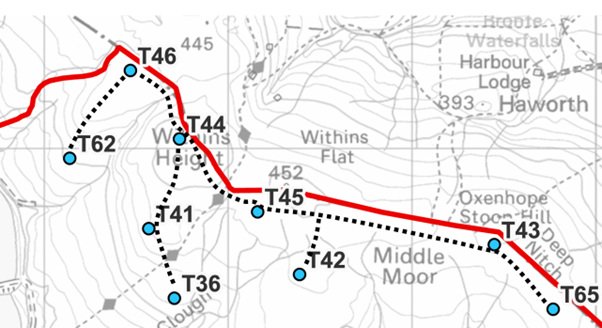
The natural walking route on CWF is always the route the blades must take. If you try to contour below the edges you find yourself among groughs and cloughs, easy only for Airedale terriers. The spine road runs along the boundary and the lower turbines are served by tracks running downhill, that must act as Hebden-bound flumes in a downpour and as constant efficient drains for the deepest peat on the top.
I’m still not happy with the solution to T36 Dean Stones Edge, with its steep rake across the Pennine Way from T41, but this site is cut off from the east by extensive drainage. Like T62 today on Burnt Hill Flat, Dean Stones Edge offers a flat platform, but it can’t be reached without building a flume. While I was working on this point, I decided it was time for my first scale map of the infrastructure.

We frequently explain to men (they are always men) why this black area emits so much carbon. The tracks are drained by ditches either side, as are the turbine foundations and crane hardstandings. This extensive new drainage lowers the water table and dries out the peat well beyond the infrastructure; exposed carbon oxidises to CO2 exposing further peat and the cycle continues. The plume of CO2 would once have been offset by displaced coal and gas generation elsewhere, but after decarbonisation in 2030 (Labour) or 2035 (Conservative) there isn’t any displaceable fossil generation.

One good thing that survives Christopher Wilson’s torching of Dr Osman’s money on the abandoned Scoping Report is the peat survey map. I think this may have cost Dr O £200,000 and it is a potent resource for understanding Walshaw Moor. Given any turbine layout, the road network can be solved and the carbon intensity calculated. Given a megawattage I can now do a minimum carbon intensity estimate on Walshaw Moor in about four hours. This was impossible before I knew the ground because I couldn’t solve the track network.
The smoking ruins of 302 MW CWF had no chance at DESNZ anyway because its carbon intensity is more than 60 gCO2/kWh. UK carbon intensity in 2035 will be 41; it will be 12 by 2050 (and -4 in North America.) Proper new wind farms not built on peat are already at 12. We can build 1.5 GW of proper wind farms for the carbon price of 302 MW CWF.
The Executive Chairman has helpfully blabbed that CWF is uneconomic at 200 MW (we’d never have been sure about that!) but that was before he had taken in the news (if he ever did) that the onsite aggregate is weak and porous, with trucked-in limestone adding a lot of cost, delay, and aggravation to locals who may engage in passive resistance by continuing to park their cars outside their cottages. Nonetheless, I did the carbon intensity for a couple of 170 MW layouts following the startling new FAQ 17 announcement. Neither got below 30 so that’s still hopeless for DESNZ. At 170 MW the layouts are ruinously expensive, with a long tail east to the blade access pumping out CO2, and that awful trench from Shackleton to Rochdale gobbling the billpayers’ money as they pay back the mortgage to the Ontario teachers.
CWF Ltd doesn’t exist in the way Tesco does. Financially it is a shell company. It only has an option on Walshaw Moor. A skeleton senior staff at CWF Ltd (fewer than three perhaps, given the flaky FAQs) outsource work to consultants who are glad of the business and need have no loyalty to the shell. Having perpetrated the public nuisance of an unviable 302 MW application to Calderdale Council they dumped their own scoping report and wiped down their website. CWF Ltd could be packed up in an hour or abandoned in a field like a festival tent. The venture capital caravan moves on to other bets.
When or if CWF II Ltd returns “in the Spring of next year” it cannot be Wacky Races anymore. If it is, Dr Osman’s Geordie mates in Blyth may start to tease him. “Haddaway Muttley and loss yasel!” A less amateur CWF II Ltd will be much more dangerous to wildlife, climate and the billpayers because they might persuade DESNZ to let them build a huge wind farm on a remote SPA at over 60 gCO2/kWh.
We (there are lots of us!) shall keep walking to the turbine sites. CWF is a laboratory for thinking about wind generation on peat and the tensions in the nature and climate crises. There will be other, always more competent, venture capital raids on Bronze Age protected peat in the next five years until this settles down in England. It will settle faster because we have in front of us the grim memento mori of Scottish wind generation on peat. The climate must take a tartan CO2 beating for decades after this tragic conjunction of post-Clearances landowners with central belt nationalism.
At more than 60 gCO2/kWh, CWF Ltd’s abandoned wind farm was bad for Net Zero, but what about Energy Security? All of Christopher Wilson’s “Seventy-two Views of Calderdale Wind Farm” impose an opportunity cost by wasting resources. This is because Walshaw Moor is too hard to reach, too far from the connection, and its onsite rock is too weak and porous for concrete or roadstone aggregate. We can buy much more energy security for the same amount of the billpayers’ money.
This is what Ed Miliband said on 17 September 2024;
“That means that if we are serious about energy security, family security, economic security and national security, we need the greater energy independence that only clean energy can give us [… ] Every wind turbine we put up, every solar panel we install, every piece of grid we construct helps protect families from future energy shocks.”
This rhetoric is unserious about energy security because it ignores the opportunity cost of wasteful spending. Miliband’s “Every turbine” sloganising wouldn’t survive a minute in any A-level Economics class in the country. Bad wind farms waste resources that could have been used for good wind farms.

Mr Miliband (PPE (Oxford), Economics (LSE)) may also believe that “Every centimetre added to an avalanche probe saves lives.” Skiers know the grim opportunity cost of this bien pensant thinking. If their friends are more than three metres down, they are as good as dead. With seconds critical, four-metre avalanche probing would kill people who are only two metres down and might have lived had they been found in time.
If Mr Miliband makes climate change worse while destroying nature and compromising energy security on Walshaw Moor he will have made one of Peter Cook’s Futile Gestures;
“I want you to lay down your life, Perkins. We need a futile gesture at this stage. It will raise the whole tone of the war. Get up in a crate, Perkins, pop over to Bremen, take a shufti, don’t come back. Goodbye, Perkins. God, I wish I was going too.”
“Goodbye, sir — or is it — au revoir?”
“No, Perkins.”
++++++++++++++++++++++++++++++++++++++++++++++++++++++

++++++++++++++++++++++++++++++++++++++++++++++++++++++++
This is the 21st in a series of 65 guest blogs on each of the wind turbines which Richard Bannister plans to have erected on Walshaw Moor. Turbines 5, 6, 8, 9, 11, 17, 25, 27, 32, 33, 34, 35, 40, 43, 44, 47, 54, 56, 58 and 64 have already been described. To see all the blogs – click here.
[registration_form]
I agree with Mark Avery’s point about the government’s consideration of banning windfarms on protected peatland. Calderdale Wind Farm are indeed regrouping and the Stronger Together to Stop Calderdale Windfarm campaign’s take on their “project update” last Friday is here: What has Calderdale Wind Farm got to hide? Everything, apparently – link: https://saverestorewalshawmoor.wordpress.com/2024/10/19/what-has-calderdale-wind-farm-got-to-hide-everything-apparently/
When reading Nick’s blog, please bear in mind the main Stronger Together campaign message is the need for the government’s proposed NPPF reforms to include a ban on windfarms on peat. We are making this point to our MPs and the Secretary of State for Energy Security and Net Zero in a way that encourages Ed Miliband in his view that you can’t solve the climate crisis without also solving the nature crisis. This is REALLY URGENT AND IMPORTANT. We only have 2 months to convince our MPs and the government – the team running the public consultation on the government’s proposed National Planning Policy Framework reforms have told us the government will have made the changes by the end of the year.
So the ‘ban windfarms on protected peat” message is crucial, urgent and the main focus of the Stronger Together campaign.
We hope that we may well be pushing at an already half-open door, because the government’s recent public consultation on its proposed reforms to the National Planning Policy Framework acknowledged the necessity of additional protections for peatland and asked for people’s views about this. Of course, we said yes, and said the additional protections should be to entirely exclude protected peatland as a site for wind farms. And so did other organisations.
If/when we win this ban on windfarms on protected peatland, all the other secondary issues in Nick’s blog will go away. So that’s what Stronger Together are pushing for and focussing on. For info, here’s what the campaign’s been doing since the general election https://bit.ly/3YeNNux
Nick is like a fabulously articulate King Arthur – returned to save this precious piece of England. These blogs are superb.
Good news at least for now , thanks for the double update!
Another excellent blog from Nick. Thanks for such indepth research, well written text and those hilarious sections that has me chortling into my cuppa.
Thank you Nick and all those involved in trying to save our peat moors, your efforts are much appreciated.
The wayback ‘machine’ appears to have snapshots of calderdalewind.co.uk
https://web.archive.org/web/20240000000000*/https://calderdalewind.co.uk/